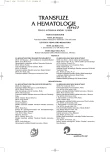Is WT1 gene hyperexpression a malignant cells marker?
Je vysoká exprese genu WT1 znakem nádorových buněk?
Význam exprese genu WT1 v blastech akutních leukemií a myelodysplastického syndromu (MDS) byl opakovaně prověřován s nejednoznačnými výsledky. V naší studii jsme se zaměřili na stanovení exprese WT1 pomocí kvantitativní PCR v diagnostických vzorcích dětských pacientů s akutními leukemiemi (n = 113), myelodysplastickým syndromem (n = 14) a aplastickou anémií (n = 25). Jako kontroly byly vyšetřeny vzorky kostních dření zdravých dárců a vzorky pupečníkových krví (n = 35), které exprimují gen WT1 na velice nízké nebo nedetekovatelné hladině. Exprese genu WT1 v blastech akutních myeloidních (n = 62) i lymfoblastických leukemií (n = 51) se pohybovala v širokém rozpětí. Vysoká exprese byla u lymfoblastických leukemií spojena s přítomností hybridního genu MLL/AF4, zatímco BCR/ABL a TEL/AML1 pozitivní pacienti měli expresi nízkou. T buněčné lymfoblastické leukemie exprimovaly gen WT1 v širokém rozmezí. U myeloidních leukemií byla vysoká exprese spojena s méně zralými subtypy (zejména se subtypem M3), naopak leukemie subtypu M5 exprimovaly na signifikantně nízkých hladinách. Pacienti s aplastickou anémií mají velice nízké nebo nedetekovatelné hladiny transkriptu WT1, zatímco pacienti s myelodysplastickým syndromem souhrnně exprimují gen WT1 na vyšší hladině. Při porovnání pacientů s aplastickou anémií se skupinou pacientů s myelodysplatickým syndromem typu refrakterní anémie byl nalezen statisticky významný rozdíl (p = 0,0079). Význam stanovení hladiny transkriptu WT1 pro diferenciální diagnostiku těchto chorob je však omezený kvůli překryvu naměřených hodnot. Nízká exprese genu WT1 v blastech některých subtypů akutních leukemií dokazuje, že hyperexprese genu WT1 není „panleukemickým“ markerem.
Klíčová slova:
aplastická anémie, myelodysplastický syndrom, akutní leukemie, qRT-PCR, exprese genu WT1
Authors:
M. Kalinová 1,2; K. Mužíková 1,2; L. Šrámková 1,2; J. Starý 3; J. Horák 4; J. Trka 1,2
Authors‘ workplace:
CLIP – Childhood Leukaemia Investigation Prague
1; Laboratorní centrum Kliniky dětské hematologie a onkologie, UK 2. LF Praha
2; Klinika dětské hematologie a onkologie, UK 2. LF Praha
3; Gynekologicko-porodnická klinika, UK 2. LF a FNM Praha
4
Published in:
Transfuze Hematol. dnes,12, 2006, No. 2, p. 76-82.
Category:
Comprehensive Reports, Original Papers, Case Reports
Overview
WT1 expression in myelodysplastic syndrome (MDS) was repeatedly tested with unequivocal results. In our study we concentrated to the determination of WT1 expression using quantitative RT-PCR in the diagnostic samples of paediatric patients with acute leukaemia (n=113), myelodysplastic syndrome (n=14) and aplastic anaemia (n=25). We used normal bone marrow samples and cord blood samples (n=35) with very low or undetectable expression as the negative controls. The expression levels in both the blasts of acute myeloid (n=62) and lymphoblastic (n=51) leukaemia widely varied. High expression was linked to the presence of MLL/AF4 fusion gene in contrast to BCR/ABL and TEL/AML1 fusion. T-cell leukaemias expressed WT1 in a wide range. In AML, high WT1 expression was linked to less mature subtypes (particularly M3), in contrast M5 subtype expressed significantly less WT1. Aplastic anaemia patients had very low or undetectable WT1 transcript levels, whereas myelodysplastic syndrome patients expressed WT1 on a higher level. Comparison of patients with aplastic anaemia to the refractory anaemia subtype of myelodysplastic syndrome revealed statistically significant difference (P=0,0079). However, the significance of WT1 expression estimation is limited due to the overlap of measured values. Lower WT1 expression in blasts of some of the acute leukaemia subtypes clearly demonstrates that WT1 hyperexpression is not a „panleukaemic” marker.
Key words:
aplastic anaemia, myelodysplastic syndrome, acute leukaemia, qRT-PCR, WT1 gene expression
Labels
Haematology Internal medicine Clinical oncologyArticle was published in
Transfusion and Haematology Today

2006 Issue 2
- Cost Effectiveness of FVIII Substitution Versus Non-Factor Therapy for Hemophilia A
- Vascular Disease in the Gradually Aging Population of Hemophiliacs: An Underestimated Problem?
- Prognostic Significance of Subclinical Joint Changes on MRI in Hemophilia
- Immunotolerance is still the goal of management of hemophilia A with inhibitor in the era of non-factor therapy
- Minimum and Optimal Factor Levels in Physically Active Hemophiliacs
Most read in this issue
- Chronic idiopathic myelofibrosis: biological characterization and histological “grading” of the fibrosis with respect to diagnosis and prognosis
- Anagrelide in the treatment of thrombocytosis in myeloproliferative disease – case report
- Hemorrhagic complications during warfarin therapy
- Idiopathic thrombocytopenic purpura in pregnancy refractory to immunosuppressive treatment – case report
